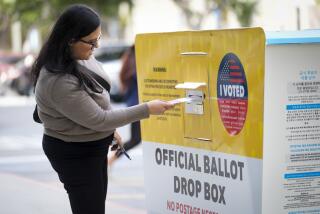Report Card Explained
- Share via
Recent editorials have left an impression that the Sierra Club’s evaluation of the San Diego City Council’s voting record on environmental issues is somehow flawed. Let’s consider some of the concerns that have been expressed.
Why do public interest groups, such as the Sierra Club, even produce such report cards?
One of the important functions of these watchdog groups is to determine the voting records of politicians and to share that information with interested citizens. Every member of the council claims to be environmentally sensitive; yet historically, neither the public nor the media had the statistics to explore or challenge their proclamations. For this reason, the San Diego Chapter of the Sierra Club has devoted significant resources to report card efforts over the past three years. Its reports have been praised for their thoroughness and have served as models for other groups throughout the nation. What types of issues were included in the report and why were they chosen? The votes in the current report cover a broad range of topics, including growth management, sensitive lands protection, recycling, parks, water and air quality, sewage, toxic wastes, housing, transportation and open space preservation. The report spells out how the defeat of a project to fill a Normal Heights Canyon with housing protected our city’s open spaces and who voted to protect us. It provides details about the votes on many other important issues.
The members of the council cast the votes on these environmental issues. The report card only tallied them and explained why they were important. The club hopes that members of our community will find this information useful.
Why was the August cutoff date used and why was the score card published at this time?
The City Council takes a recess in August. It therefore attempts to wrap up business in anticipation of their vacations. So August provides a fair break point. Reviewing public documents, summarizing actions and preparing the analysis is a time-consuming process. In fact, the task took Sierra Club staff and volunteers 2 1/2 months. It was also timed to remind council members that they will be watched as they vote on protecting the urban reserve, preventing the division of Mission Trails Regional Park by a major expressway and preserving our sensitive lands through a resource protection ordinance.
Why was an absence factor included in the overall score?
Last year, the Sierra Club was criticized because some members of the council obtained high environmental ratings by missing many important votes. It is not right to let our decision makers duck taking stands. Therefore absences were handled in this years report by counting each missed roll call as half a wrong vote.
What are the Sierra Club’s plans for future reports?
Recent council actions makes it clear that there is a need for more focus on the details in a few of the more important decisions. The current rating system does not give more weight to important votes, such as protecting a park from Jackson Drive, than to votes on standard Earth Day proclamations. The club will seek advise on how to best deal with this in future report cards. It plans to continue to publish the information needed to help San Diegans challenge their elected officials to make environmentally sound decisions. Look for the Sierra Club’s report on the Board of Supervisors in a few more months.
ROB LANGSDORF, Chairman, San Diego Chapter, Sierra Club
More to Read
Sign up for Essential California
The most important California stories and recommendations in your inbox every morning.
You may occasionally receive promotional content from the Los Angeles Times.









